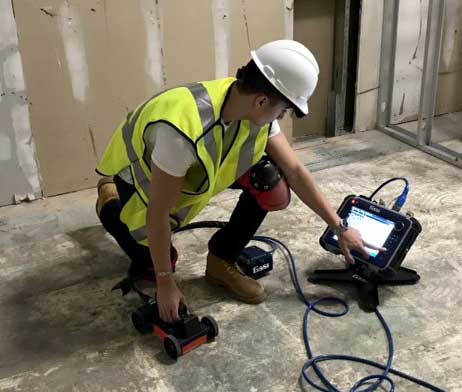RainierGPR Service Areas: Where We Provide Premier Concrete Scanning
RainierGPR Service Areas: Where We Provide Premier Concrete Scanning
Blog Article
Concrete Scanning: A Critical Action Towards Making Sure Architectural Stability and Security
In the world of building and infrastructure upkeep, the relevance of concrete scanning can not be overstated. This precise procedure holds the key to unveiling possible threats concealed beneath the surface of apparently strong frameworks. By utilizing innovative innovation and methods, concrete scanning functions as a crucial tool in guaranteeing that the integrity and safety and security of structures and bridges are upheld to the greatest criteria. However, beyond its surface-level ramifications, the role of concrete scanning extends much deeper than satisfies the eye.
Value of Concrete Scanning
Concrete scanning plays a crucial role in making sure the architectural honesty and security of buildings and infrastructure projects. By making use of innovative technologies such as ground-penetrating radar (GPR) and electromagnetic induction, professionals can non-destructively inspect concrete structures to detect potential flaws, voids, embedded objects, and support design. This procedure allows early discovery of abnormalities that could jeopardize the stability of a structure, stopping pricey problems and making certain the safety and security of owners.
Concrete scanning is especially vital throughout the preparation and building and construction stages of a project. Prior to exploration, reducing, or coring right into concrete, scanning assists determine the specific areas of rebar, post-tension cable televisions, and other embedded elements, reducing the threat of accidental hits that might lead to structural weaknesses. In addition, concrete scanning help in quality assurance by verifying the density of concrete covers and detecting any inconsistencies that might influence the general resilience of the framework. Inevitably, buying concrete scanning solutions is not just a positive step to mitigate dangers but additionally an essential step in the direction of maintaining the lasting safety and security and security of structures and facilities.
Innovation for Concrete Examination

Benefits of Early Detection
Prompt detection of structural problems can significantly minimize dangers and make certain the longevity of building jobs. By determining potential issues beforehand in the building and construction process, stakeholders can take proactive procedures to resolve concerns prior to they escalate into larger and a lot more expensive issues. Among the crucial advantages of very early discovery is the avoidance of architectural failings, which can posture major security dangers and cause job hold-ups and financial losses.
In addition, early detection permits timely fixings and upkeep, which can aid prolong find more the life expectancy of the framework. By resolving concerns immediately, building teams can avoid costly repairs or even the demand for early replacement of structural components. This proactive approach not just saves money and time however also enhances the total security and toughness of the construction task.
Furthermore, early discovery can enhance job preparation and decision-making by offering stakeholders with useful understandings into the condition of the structure. Armed with this details, task supervisors can make enlightened selections relating to building and construction approaches, materials, and timelines, causing much more effective and efficient job outcomes.
Guaranteeing Architectural Stability
Ensuring the architectural stability of a building job is vital to its safety and security and longevity. Architectural security refers to the capacity of a building or facilities to keep its form and feature under ecological conditions and numerous loads. To accomplish this, comprehensive analysis and surveillance of the structure are crucial. Concrete scanning plays a vital duty in guaranteeing architectural stability by discovering possible issues such as voids, delamination, or reinforcement corrosion that could jeopardize the stability of the framework gradually.
By utilizing sophisticated scanning innovations like ground-penetrating radar (GPR) and electromagnetic induction, building and construction professionals can non-invasively check concrete frameworks to determine locations of worry below the surface. This positive method enables the early discovery of defects or weak points, making it possible for timely repairs or reinforcement to avoid architectural failings.
Routine concrete scanning during different construction stages and throughout the life process of a structure can aid maintain its security, reduce risks, and ensure the safety and security of residents. By focusing on structural security with concrete scanning, building jobs can enhance their durability and sturdiness, eventually contributing to greater security and durability.

Avoiding Vital Failings
To protect versus disastrous events, precise surveillance and positive maintenance are imperative in avoiding vital failures within architectural frameworks. Discovering potential issues before they escalate is crucial to avoiding architectural failings. Executing regular my response evaluations, such as concrete scanning, can disclose covert issues like spaces, splits, or rust that can compromise the stability of a structure. By using innovative scanning innovations like Ground Passing through Radar (GPR) or Concrete X-ray, engineers can non-destructively assess the condition of concrete and recognize weak factors that require support or repair work - RainierGPR Service Areas.

Conclusion
Finally, concrete scanning plays an essential function in guaranteeing structural stability and security by using sophisticated modern technology for early detection of possible problems. This aggressive technique assists protect against crucial failings and guarantees the security of frameworks. It is important to prioritize concrete examination as a standard technique to shield the long life and safety of buildings and framework.
Concrete scanning plays a critical duty in ensuring the architectural honesty and safety of structures and infrastructure projects. Additionally, concrete scanning help in quality control by confirming the density of concrete covers and identifying any discrepancies that might affect the total resilience of the structure. Concrete scanning plays an essential function in ensuring architectural security by spotting prospective straight from the source issues such as voids, delamination, or reinforcement rust that might compromise the integrity of the framework over time.

In final thought, concrete scanning plays an important role in making sure architectural honesty and safety and security by making use of innovative innovation for very early detection of potential problems.
Report this page